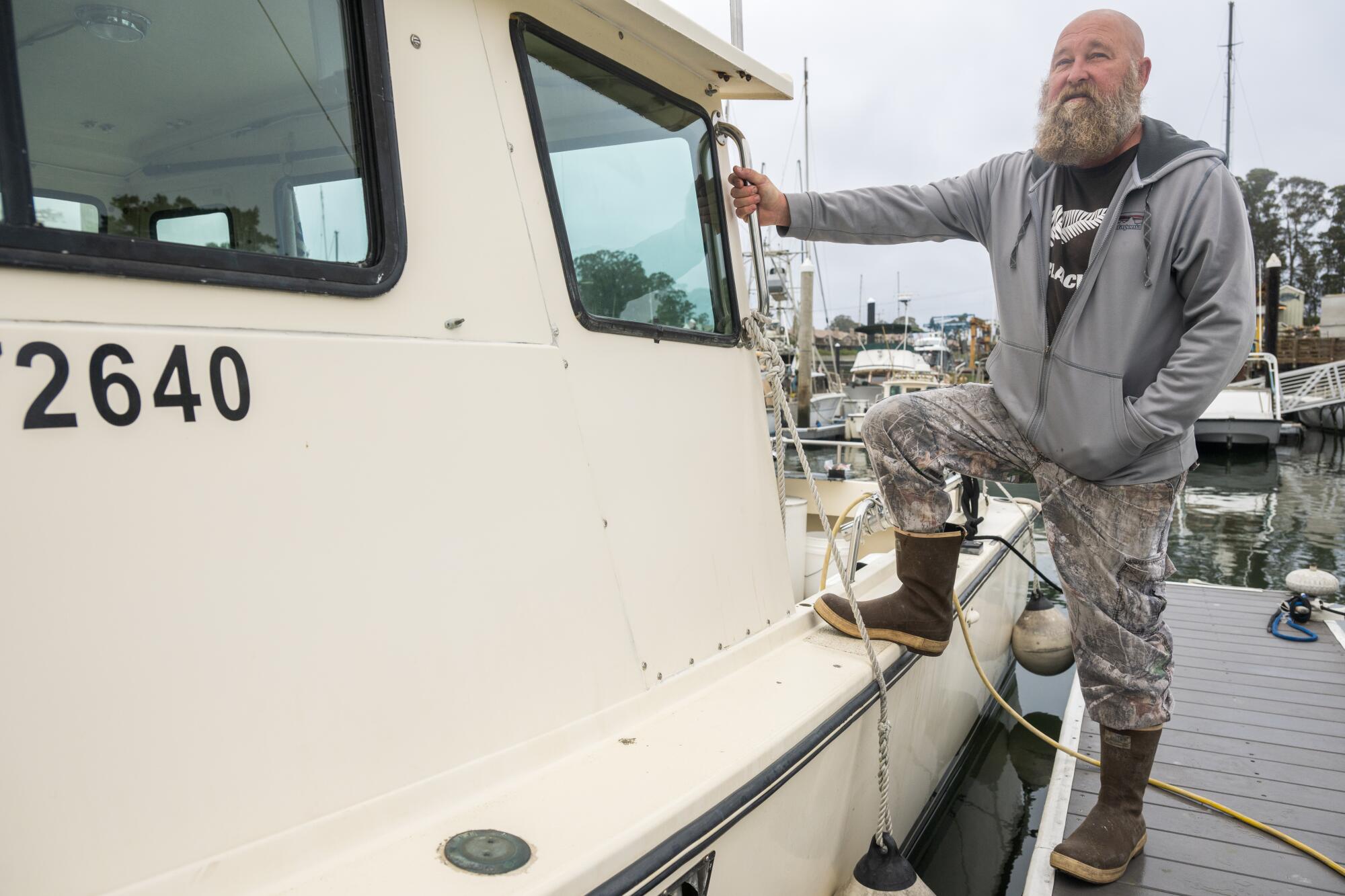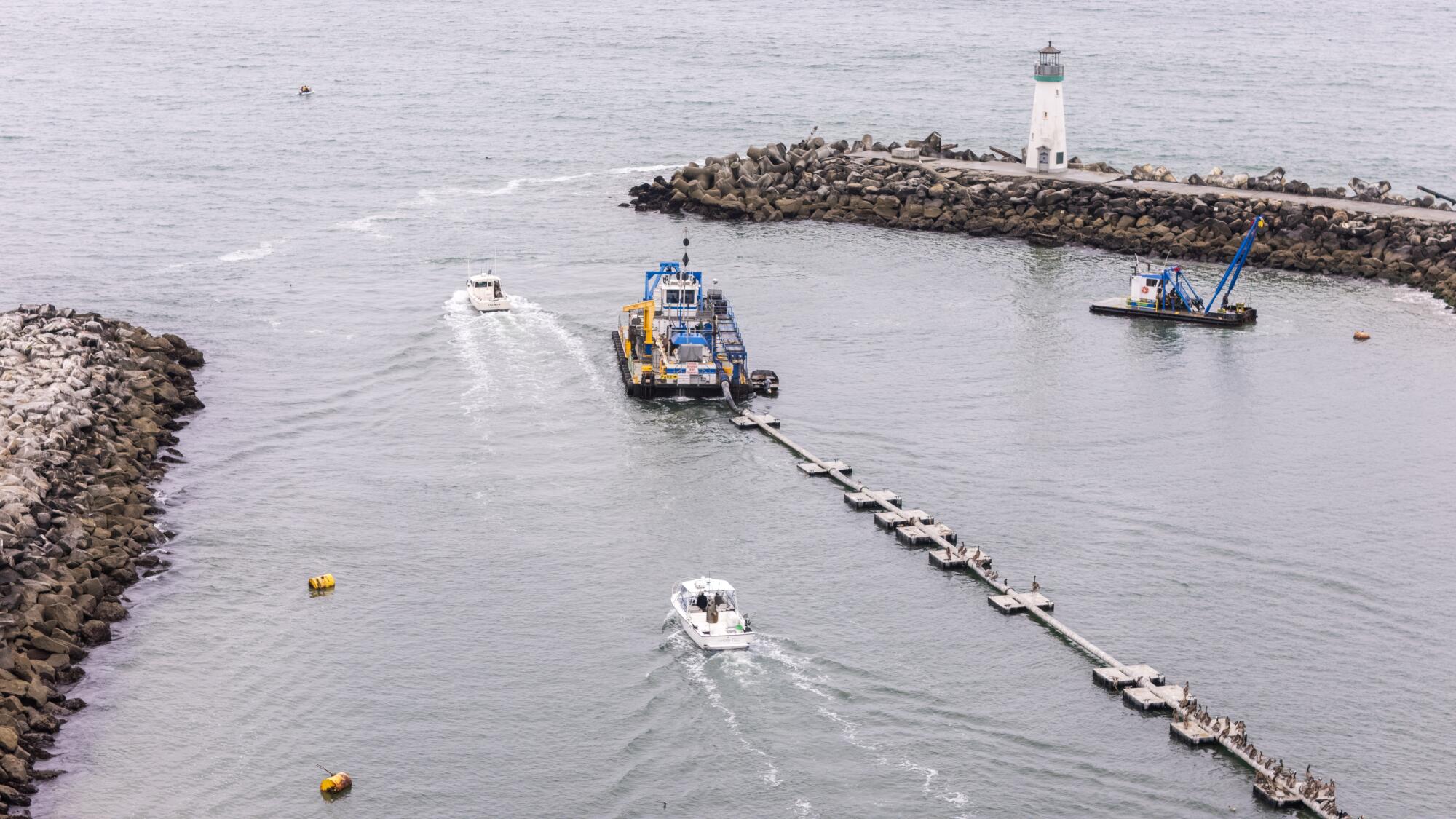
- Share via
- Fishery regulators have voted to ban commercial fishing for Chinook salmon along the California coast for an unprecedented third consecutive year because of low population numbers.
- A fishery management council also called for a limited season for recreational fishing on certain dates and with strict quotas.
- Salmon populations have declined sharply in recent years. “It is a huge emergency,” one expert says.
Fishery regulators on Tuesday called for shutting down commercial salmon fishing along the California coast for an unprecedented third year in a row in an effort to help the declining population of Chinook salmon recover.
The Pacific Fishery Management Council, a body established by Congress that manages ocean fishing along the West Coast, voted 13 to 1 to recommend banning all commercial salmon fishing off California, a decision the National Marine Fisheries Service is expected to adopt in May.
As part of the vote, held at a meeting in San Jose, the council called for allowing some limited recreational salmon fishing for the first time since 2022. The ocean recreational fishing season will be restricted to several days in the summer and fall, and the total catch will also be strictly limited.
The suspension of fishing for the last two years has brought major losses of income for those in the fishing industry, but some salmon boat skippers agree that extending the closure is needed.
“We need to do everything we can to save the species,” said Kevin Butler, a commercial fisherman in Santa Cruz.

The fishing season typically runs from May to October, and in recent years the state’s commercial salmon fishing fleet has numbered about 460 vessels. But many boat owners and crew members have recently turned to other work to make ends meet. Some have put their boats up for sale.
Butler said salmon previously represented about three-fourths of his income. He has continued fishing for halibut and lingcod, earning much less.
“Every fisherman has sacrificed everything for two years,” Butler said. He said that for himself and others, being unable to catch salmon has meant “insane financial hardship, stressing of your family’s relationships, everything.”
“If the majority of your income disappeared, what would you do? Go find a new career? Well, that’s a tough one for fishermen. We’ve fished our whole life,” he said. “This is a life, this is a love.”
Although severe drought from 2020-22 contributed to the decline, those who work in fishing also blame California’s water managers and policies for the low salmon numbers, saying too much water has been pumped to farms and cities, depriving rivers of sufficient cold water at the times salmon need it to survive.
“It’s a water mismanagement issue,” Butler said. He blamed Gov. Gavin Newsom’s administration, saying the state has prioritized water supplies for the $59-billion agriculture industry to the detriment of salmon.

Biologists say salmon populations have declined because of a combination of factors including dams, which have blocked off spawning areas, the loss of vital floodplain habitats, and global warming, which is intensifying droughts and causing warmer temperatures in rivers.
During the severe 2020-22 drought, the water flowing from dams sometimes got so warm that it was lethal for salmon eggs. And because salmon typically feed in the ocean for about three years and then return to their natal streams, the decline in the numbers of surviving juvenile fish during the drought left a reduced population of adult fish.
The state’s policy of pumping heavily from rivers is “killing entire salmon runs, and it’s beating down hardworking men and women trying to make a living from fishing,” said Scott Artis, executive director of Golden State Salmon Assn., a nonprofit group that represents fishing communities. “This closed commercial and token recreational fishing season is a human tragedy, as well as an economic and environmental disaster.”
He said his group is asking for “a little cold water to be left in our rivers for baby salmon so they can survive and return as adults.”
California’s fishing fleet depends on catching Chinook salmon. Low population numbers could lead regulators to shut down or sharply limit fishing this year.
State officials said that in addition to drought and global warming, salmon populations have been struggling because of wildfires, poor conditions in rivers, algae blooms and problems of thiamine deficiency in salmon linked to shifts in their ocean diet.
“Salmon populations are still recovering from severe drought and other climate challenges and have not yet benefited from our consecutive years of wet winters and other actions taken to boost populations,” said Charlton “Chuck” Bonham, director of the California Department of Fish and Wildlife. “After years of full closure for salmon fishing, the opportunity for limited recreational salmon fishing brings hope. We know, however, that this news brings little relief for California’s commercial salmon fisheries.”
Coastal salmon fishing was banned for two consecutive years once before, in 2008 and 2009. This is the first time the commercial season is set to be canceled for three years straight.
The Pacific Fishery Management Council cited the latest state estimates showing the number of Sacramento River fall-run Chinook salmon remains very low, with an estimated 166,000 fish in the ocean this year — down from a preseason estimate of 214,000 last year, and similar to the 2023 estimate of 169,000 fish.
Those figures represent a drop from the much larger numbers of salmon, in some years more than 1 million fish, that teemed along California’s Pacific coast in the early 2000s.
“It’s another unambiguous signal that salmon are declining in California, alongside many of the other native fishes,” said Andrew Rypel, director of Auburn University’s fisheries school and former director of the UC Davis Center for Watershed Sciences. “It’s really very sad. I think it’s an indicator of how we’ve managed the resource over time, and that we’re failing salmon.”
The shutdown of fishing has taken a toll not only on the commercial fishing fleet but also on operators of charter fishing boats who were unable to fish for salmon in 2023 and 2024. Under the council’s decision, recreational anglers are set to be allowed limited ocean fishing under state-administered quotas in two windows in the summer and fall, the first of which is set to open June 7-8 and allow for up to 7,000 salmon to be caught.
State regulators also set rules for inland recreational fishing on rivers, and the California Fish and Game Commission will decide this year’s season at meetings this month and in May.
Before the shutdown, Jared Davis used to earn much of his income leading sportfishing tours out of Sausalito on his 56-foot boat Salty Lady. Lately, he has been turning to other types of cruises, leading whale watching tours and holding ash-scattering burials at sea.
“It hurts that the salmon fishing has been shut down. It definitely hurts,” Davis said. “I just did my taxes and my deckhand made more than I did over these last couple years.”
Because of declining salmon populations, California has canceled fishing in rivers for a second year. The decision mirrors the shutdown of coastal fishing.
He said he supports the planned regulations, which he views as a conservative approach to help the population recover.
The fishing industry depends on fall-run Chinook, which migrate upstream to spawn from July through December.
Other salmon runs have suffered more severe declines. Spring-run Chinook are listed as threatened under the Endangered Species Act, and winter-run Chinook are endangered.
The pattern that has emerged in successive droughts is a long-term, “stair-step” decline, in which salmon and other species suffer a drop during dry years and then fare somewhat better during wetter times, but their numbers don’t come back up to what they were previously, Rypel said.
Because the fish largely have a three-year life cycle, the population should improve somewhat next year because of the boost they received during 2023’s historic wet winter, Rypel said, but in the long term, the fish are still struggling.
Changes that would help salmon include having larger flows in rivers at the right times to support fish, and opening up more floodplain habitats to support their recovery, Rypel said.
For decades, government-run hatcheries in the Central Valley have reared and released millions of salmon each year to help boost their numbers.
State officials say the Newsom administration’s ongoing efforts to help salmon populations recover include restoring tidal habitats, modernizing infrastructure, removing barriers that hinder fish migration and reintroducing salmon in traditional spawning areas upstream from dams.

Despite those efforts, the situation facing California’s salmon remains so dire, Rypel said, that agencies should be taking more chances to prevent the fish from suffering even larger declines.
“It is a huge emergency,” he said. “We need to be trying big things at this point, big experiments.”
Rypel said he feels for the people whose livelihoods have been upended by the fishing closures.
“It’s always been a California way of life, and it’s very much in jeopardy,” he said.









